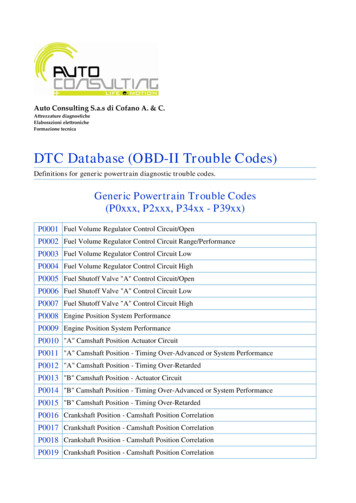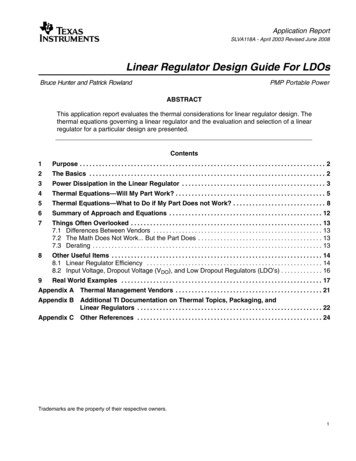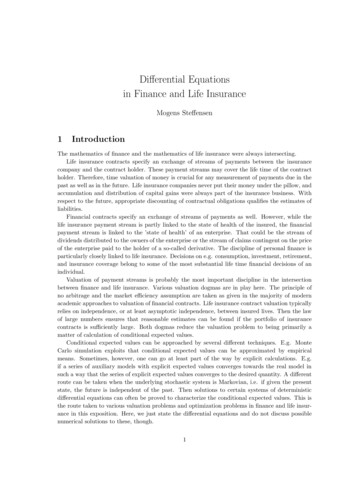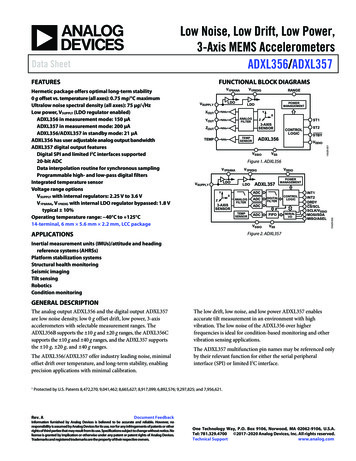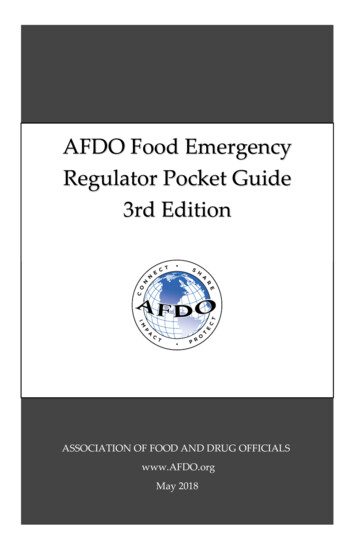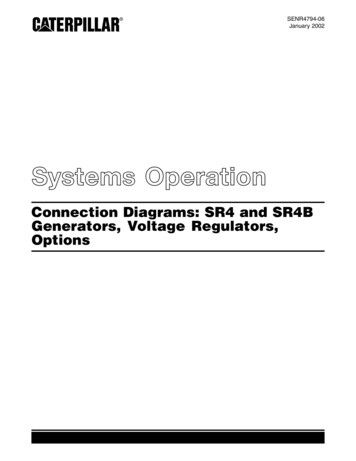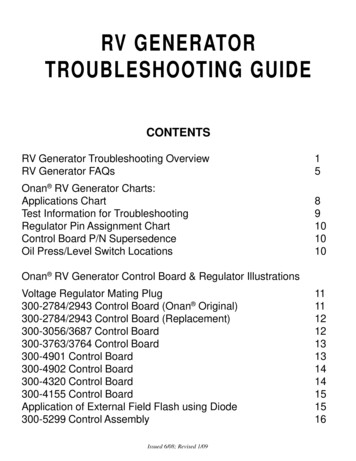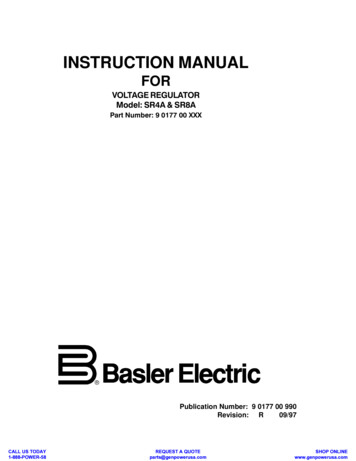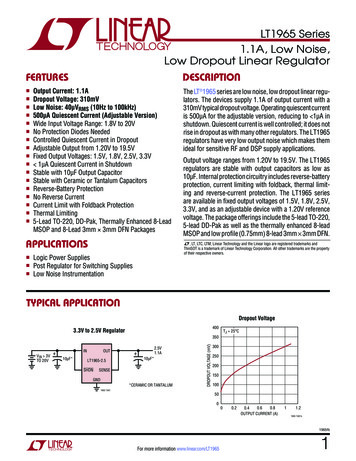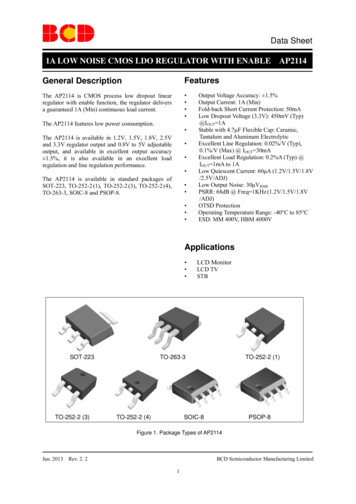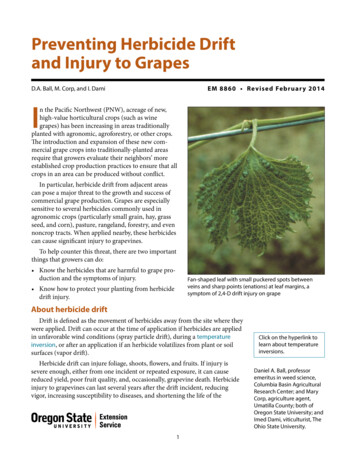
Transcription
Draft: 10/31/18Adopted by the Executive (EX) Committee and Plenary, TBDAdopted by the Property and Casualty Insurance (C) Committee, TBDA REGULATOR’S GUIDETO PET INSURANCE
TABLE OF CONTENTSINTRODUCTION . 3HISTORY . 6CARRIERS . 10COVERAGE OPTIONS . 11POLICY FORMS. 14MARKETING STRATEGIES. 15LICENSING . 15RATES . 19RATING . 21RATING VARIABLES . 22RATING EXAMPLE. 26RATEMAKING . 27RATEMAKING EXAMPLE . 28ANNUAL STATEMENT DATA . 31CLAIMS PRACTICES . 32REGULATORY CONCERNS . 35RESOURCES . 40Appendix 1: Glossary of Terms . 41Appendix 2: California Assembly Bill No. 2056, Chapter 896 . 42Appendix 3: Overview of Actuarial Science . 472
INTRODUCTIONIn December 2016, an insurer in the pet health insurance (pet insurance) industry voiced concernsto the Producer Licensing (D) Task Force regarding the use of limited lines licensing for petinsurance. The insurer recommended that pet insurance be removed from the State LicensingHandbook Uniform Licensing Standard (ULS) #37 as a limited line. It was the insurer’s opinionthat a full property/casualty (P/C) line should be required to sell, solicit or negotiate pet insurance.Reasons cited include: 1) tremendous growth in the pet insurance market; 2) policy premiums thatfar exceed the cost of the covered item (i.e. the pet); 3) complex policies with multiple coverageoptions and exclusions. Traditionally, limited lines products are designed to be incidental to thesale of another product which according to the insurer is not the case with pet insurance. The TaskForce decided it needed to better understand the complexities of pet insurance before offeringguidance regarding the type of producer license required to sell the product. As a result, the TaskForce made a referral to the Property and Casualty Insurance (C) Committee to draft acomprehensive white paper providing information on coverage options, product approval,marketing, ratemaking, claims practices and regulatory concerns.As discussed during the NAIC Property and Casualty Insurance (C) Committee’s meeting at the2018 Spring National Meeting, the Committee formed a drafting group to develop a white paperto provide an overview of the pet insurance industry. This white paper represents the group’sfindings. Please note that all websites and companies discussed in this paper are included forresearch only and are not endorsements by the NAIC.Pet insurance provides accident and illness coverage for family-owned pets, primarily dogs andcats. Although pet insurance is classified and regulated as P/C insurance, it bears many similaritiesto human health insurance with annual coverage offered at an actuarially determined rate subjectto various conditions and exclusions. This coverage was started in the U.S. in 1980 and has grownsignificantly since that time.The North American Pet Health Insurance Association (NAPHIA) represents more than 99% ofthe U.S. and Canada pet health insurance industry as an advocacy group. As shown in Figure 1,the total premium volume for NAPHIA members in 2017 was approximately 1.03 billion in the3
U.S., representing 23.2% growth over the prior year. The growth of the P/C insurance industry asa whole was only 4.7% from 2016 to 2017. The direct written premium in the U.S. (including theterritories) was approximately 640 billion in 2017, so while the pet insurance market is growingfaster than the total P/C market, pet insurance still represents a small percentage of the total.FIGURE 1. PET INSURANCE PREMIUM VOLUMEAccording to a survey conducted by the American Pet Products Association (APPA), 1 in 2017,approximately 68% of U.S. households, or 84.65 million families, owned at least one pet (dog, cator other). Sixty million of these households owned at least one dog, and 47 million owned at leastone cat. There are significant opportunities for growth in the pet insurance market, withapproximately 90 million household dogs and 95 million household cats in the U.S. According toNAPHIA, as shown in Figure 2 below, approximately 1.5 million dogs and 300,000 cats wereinsured in 2017, meaning fewer than 2% of dogs and less than 0.5% of cats owned in the U.S. wereinsured in 2017. As shown in Figure 2, the number of insured dogs and cats increased 17.5% from2016 to ervices/GPE2017 NPOS Seminar.pdf4
FIGURE 2. TOTAL INSURED PETS*Source: North American Pet Health Insurance Association. State of the Industry Report s-conditions-use-state-industry-report5
HISTORYThe first “pet insurance” 2 policy was issued in 1890 in Sweden and focused on horses andlivestock. In 1924, the first policy covering a dog was issued in Sweden. In 1947, the first petinsurance policy was issued in the United Kingdom (UK). In Sweden and the UK, modern petinsurance policies are designed with the ability to cover pet medical costs and liability to thirdparties for the action of pets. Sweden has a requirement that dog owners maintain liability coverageand, as a result, 60% to 70% of pet owners retain pet insurance. In the UK, 25% to 30% of dogand/or cat owners maintain pet insurance.The first pet policy in the U.S. was issued in 1982 by Veterinary Pet Insurance (VPI). VPI wasfounded by a veterinarian from Orange County, CA. For the majority of the 1980s and ’90s, VPIhad a near monopoly over the U.S. market. In the early 2000s, additional companies joined themarket. At the time, VPI had approximately 80% of the market. As shown in Figure 3 below, VPI,which was purchased by Nationwide and operating under that name, maintained more than 35%of the market for pet insurance in 2017. The market has grown significantly from the 1980s totoday. Figure 1 above shows the remarkable growth over the prior five years alone.The use of the term “pet insurance” in this paper does not refer to insurance policies that cover horses andlivestock, commonly referred to as “blood stock,” which provides indemnity for animal mortality. The term “petinsurance” in this paper refers to the products commonly covering dogs and cats and providing indemnity for thecost of dogs’ and cats’ medical treatment. All of the participants in the market cover cats and dogs. A few alsocover horses and exotic animalss kept as pets.26
FIGURE 3. TOP SELLERSCOMPANY/BRANDING ENTITY*USD (IN MILLIONS)*MARKETSHARENationwide 374.6036.33%Trupanion 191.6018.58%Healthy Paws Pet Insurance and Foundation 123.2011.95%Petplan Pet Insurance 83.608.11%Crum & Forster Pet Insurance Group 69.206.71%Other 188.8018.32%TOTAL 1,031.00100.00%*Source: North American Pet Health Insurance Association. State of the Industry Report s-conditions-use-state-industry-reportFigure 3 shows the U.S. 2017 premiums written by the top five insurers and branding entities withtheir 2017 premiums written established for the sale of pet insurance. Branding entities areprograms that can be underwritten and sold by multiple insurers and are subject to change.Additionally, insurers may underwrite a variety of pet insurance programs. Branding entities mayhave programs underwritten by multiple insurers, and insurers may underwrite for multiple brands.The use of brand names is common in the industry which, without proper disclosure can causeconfusion for state insurance regulators and consumers to determine the entity with a duty toindemnify.Although the U.S. market has been growing by 15% or 20% a year for the last five years, it stillonly covers approximately 1% of the estimated 1.1 million dogs and cats kept as pets in the U.S.As noted in Figure 4, pet insurance coverage is concentrated in larger urban areas, with Californiaand New York being the largest markets. However, over the last two decades, product offeringshave expanded as additional insurers have entered the market. Caution should be used whencontemplating data contained in Figures 1 through 4. Data for these figures was provided by theindustry association NAPHIA, not the states or the NAIC. Data contained in each of the Figures 1through 4 include NAPHIA members only and therefore are not exhaustive of the entire marketfor pet insurance. As discussed later in the paper, premiums and losses for pet insurance policies7
are contained in the inland marine line of business on the NAIC annual financial statement and,therefore, data for pet insurance specifically is indeterminate at this time.A few states have initiated data calls or market conduct examinations concerning pet insurance.Massachusetts’ data call was designed to identify pet insurance writers and their premium volumein the state. New Hampshire published a report of its data call, revealing that 20 companies filedforms in the System for Electronic Rate and Form Filing (SERFF) in 2017, but only nine reportedpremium from 2015 through 2017. The two largest companies accounted for 59% of the market inNew Hampshire in 2017.8
FIGURE 4. POLICIES AND PREMIUMS BY STATE2017Number ofPolicies ( oConnecticutDelawareDistrict of kaNevadaNew HampshireNew JerseyNew MexicoNew YorkNorth CarolinaNorth DakotaOhioOklahomaOregonPennsylvaniaPuerto RicoRhode IslandSouth CarolinaSouth est 1069,6675,05216,3951,519Number ofPolicies (%)Gross Written Premium Gross Written Premium( )(%) 1.03 B 3.79 M 2.62 M 19.21 M 1.35 M 219.54 M 30.81 M 22.65 M 4.24 M 3.87 M 64.94 M16.11 M 5.19 M 2.51 M 34.53 M 7.40 M 3.01 M 3.28 M 4.21 M 4.76 M 4.35 M 25.70 M 48.83 M 14.10 M 8.85 M 1.35 M 6.38 M 1.28 M 1.96 M 14.67 M 8.58 M 61.96 M 3.26 M 106.52 M 21.51 M 0.52 M 18.24 M 2.31 M 15.15 M 46.10 M 0.70 M 5.05 M 7.96 M 0.95 M 9.70 M 46.64 M 3.91 M 3.55 M 33.75 M 36.93 M 1.71 M 8.63 M 0.73 4.5%0.4%0.3%3.3%3.6%0.2%0.8%0.1%Source: North American Pet Health Insurance Association. State of the Industry Report s-conditions-use-state-industry-report9
A study of the more developed markets in other countries may help identify points of concern anddirect the governing of pet insurance products in the U.S. There are no filing or producer licensingrequirements in the UK or Sweden, so no instructive elements can be gleaned from their experienceon these two issues. The Canadian market is similar to the U.S. market in both products and marketpenetration, having developed over a similar time period. Pet insurers report that 70% of sales areinitiated online, and 30% are initiated through call centers.California is currently the only state with a law specifically governing pet insurance. CaliforniaInsurance Code 12880 through 12880.4 were created in 2014 and can be found in Appendix 2. Thelaws require pet insurers to disclose baseline information regarding reimbursement benefits,preexisting condition limitations, and a clear explanation of limitations of coverage includingcoinsurance, waiting periods, deductibles, and annual or lifetime policy limits. The California lawsalso provide consumers with a 30-day “free look” period in which a pet insurance policy can bereturned for a full refund. An earlier version of this bill attempted to prevent exclusions forpreexisting conditions, but was vetoed by the Governor of California. A pet insurance bill wasintroduced, but not enacted, in New York.None of the failed bills or the California statute address producer or adjuster licensing. Most statesrequire a full P/C license to sell, solicit or negotiate pet insurance, while a few states—Idaho, NewJersey, Rhode Island and Virginia—allow for use of a limited lines license.CARRIERSAs noted above, insurance companies commonly advertise pet insurance products using theinsurers’ brand name (a practice referred to as “branding”) rather than the insurance companyname. Branding is common practice in many lines of business, not limited to pet insurance andwith proper disclosure should not present any legal or regulatory concerns. Additionally, it iscommonplace in the pet insurance market for branded entities to change underwriters for their petinsurance program with some frequency. This makes it difficult for examiners to identify licensedentities associated with the sale of pet insurance products and to track compliance with regulatoryrequirements. When insurers use a brand name, the insured must read the fine print at the bottomof the advertisement, application or website to find the identity of the underwriting company. In10
addition to use of brand names, one to three agencies may sell the pet insurance products for aninsurer under a specified brand name. The agency communicates with the consumer and receivesapplications. In most cases, the agency is also responsible as a third-party administrator (TPA) forclaims processing and answering consumer inquiries. This practice can cause confusion forconsumers to determine the entity responsible for paying claims and who should be named if theyneed to file a complaint with the state insurance department.COVERAGE OPTIONSTwo coverage types are available through a majority of carriers selling pet insurance: 1) accidentonly; and 2) accident and illness. According to NAPHIA, 98% of policies written in 2017 were foraccident and illness insurance which may include embedded wellness, while 2% were accidentonly. The average premium for accident and illness plans was approximately 516, while theaverage premium for accident only plans was approximately 181 per pet in the U.S. in 2017.Some veterinary clinics offer agreements for preventive care. If the agreement is a two-partycontract between the veterinarian and consumer where no risk is transferred or assumed and nothird party is involved, these plans are not insurance. However, these may cause confusion forconsumers as they may be construed as insurance. Regulators should be aware that these exist asthey may be called upon to review the structure of the agreement.Coverage options vary by carrier. Most companies write coverage for dogs and cats only. Onecarrier also has policies for exotic pets, such as reptiles and birds. Consistent with human or nonpet coverage, plans have varying deductibles, copayments and limits. In most cases, pet ownersmust pay the vet directly and wait to be reimbursed by the insurance carrier or accountadministrator. Reimbursement methods differ. Some include a benefit schedule based on illness orinjury and coverage level. There are waiting periods and pre-coverage exams required in manycases. Pets must be above the minimum and below the maximum age limits to begin coverage.Many carriers exclude coverage for pets less than 8 weeks old or older than twelve years.Exclusions exist for preexisting conditions, and there may be limitations on coverage for hereditaryor congenital conditions as well. Definitions of conditions are inconsistent across policies and,therefore, may have varying impacts on the consumer’s ability to receive reimbursement for11
claims. Appendix 1 contains a glossary of terms as defined in California Assembly Bill No. 2056,Chapter 896, requiring use of the specified terms for all policies that are marketed, issued,amended, renewed or delivered to a California resident, on or after July 1, 2015. While there aremany different policies on the market today with various coverage options, most policies include: Two primary coverage types: accident only, or accident and illness plans.Comprehensive policies may cover reasonable and necessary veterinary expenses thatoccur during the policy period for medical management, diagnosis or treatment of apet’s condition. Veterinary expenses or services include medical advice, diagnosis, careor treatment provided by a veterinarian. Other services and medical expenses that maybe covered include the costs of the visit, prescription drugs, food, supplements andmedical equipment, , surgical procedures, physical therapy, and dental procedures. Optional wellness and preventive coverage. Such coverage may be available, whichcovers veterinary expenses during the policy period for preventive treatment ortreatment provided to preserve or improve general nutrition or health when there areno underlying symptoms of an associated diagnosed medical condition. This typicallyincludes vaccinations, flea and heartworm medication, wellness exams, blood tests,radiographs, heartworm tests, screens, urinalysis, deworming, pet identification(microchip), spaying or neutering, dental cleaning, genetic certification, etc. Different plan options. Pet health insurers may offer different plan options or tierswith varying policy limits. Description of the veterinarians and clinics that may be used under the plan. Limits, which may be annual, lifetime, per procedure, per incident or acombination. Optional coverages may have special limits. Copayments applicable to the cost of each procedure, an overall limit or otherbasis. Generally, there is a coinsurance percentage and/or deductible. Waiting periods for injury, illness and orthopedic care. Pet health waiting periodsare usually broken up into two separate periods for illness and injury, but other pethealth insurers may add longer waiting periods for specific coverages such asorthopedics or cruciate ligament events, etc. Although most of the definitions in pethealth policies for waiting periods include the language “these waiting periods are12
waived for continuous renewal,” the waiting periods may apply again if there are policychanges. Policy exclusions, which often include exclusions for preexisting conditions. Somemay even exclude coverage in renewal policies for conditions diagnosed or treated inprior coverage periods. Many policies also exclude coverage for congenital andheredity conditions, such as hip dysplasia, heart defects, cataracts and diabetes. Othertypical exclusions may include: preventive treatment or wellness care; dental care;vaccinations; flea prevention; spaying or castration; behavioral training/therapy ortreatment; procedures, services or supplements for a condition not covered by thepolicy; service or procedures not performed or prescribed by a licensed veterinarian;over-the-counter food or supplies; boarding or accommodation; transportation;grooming; membership fees; experimental and/or investigative treatment that is notwithin the standard of care; diagnosis, treatment, tests or procedures associated withbreeding etc. A schedule or plan for recovery of benefits. The vast majority of plans include areimbursement model, meaning the insured must pay out of pocket to the veterinarianand be reimbursed by the insurer. Only one carrier in the market today pays theveterinarian directly. Nondiscretionary arbitration provisions. Many contracts contain nondiscretionaryarbitration provisions. Alternatively, some pet insurance policies contain language thatset forth an arbitration process that requires peer review of the treatment provided by aveterinarian as opposed to engaging in an arbitration process conducted through theAmerican Arbitration Association (AAA).The coverage options and policy details associated with pet insurance are similar to those found inhuman health insurance. However, pet insurance is regulated and reported as P/C coverage becausepets are considered property under the law. Provisions for in-network providers, co-insurance orco-payment, exclusions for preexisting conditions, age limits and waiting periods are more similarto health insurance than P/C coverage.Consumers may want to research policy provisions on their own prior to purchase. There are anumber of consumer websites that provide guidance on pet insurance products. Consumers should13
also be aware that the price of insurance may increase substantially as the animal gets older. Thesewebsites also provide additional information on some of the policy provisions identified in theprior paragraphs.POLICY FORMSState law governs the requirements for policy review in a given line of business. State law maygovern that the state is use and file, file and use, or prior approval. File and use means that theform must be filed with the state insurance regulator but can be used before approval is obtained.Use and file means the form can be used before it is filed with the state insurance regulator. Priorapproval requires that all insurance policy forms, riders and endorsements be approved by theinsurance commissioner/superintendent/director prior to being issued and sold to the public. Whileprior approval provides the highest level of oversight because policy forms cannot be used untilapproved, use and file, and file and use still provide states with the oversight to review filings forcompliance with state-specific requirements.A basic insurance policy form is an insurance contract delineating the terms, provisions andconditions of a particular insurance product. It includes endorsements and applications wherewritten application is required and is to be attached to the policy or be part of the contract.Although state regulation of insurance was initially designed to prevent insurer insolvency,regulatory jurisdiction has evolved over the decades to protect consumers. 3 Policy form review isan integral part of market regulation. Policy forms are reviewed to ensure statutory complianceand to ensure products are fair and not harmful to consumers. Regulatory review also helpsinsurance companies as examiners may catch errors, inconsistencies, ambiguous or misleadinglanguage, and omission before products are offered to the public. This helps improve the qualityof products offered and promote consumer confidence.Policy form filings may be submitted through SERFF in most states. Currently, six states and theterritories are not using SERFF for policy filing review. Policy form filings are generally submittedseparately for each program. Insurers must be properly licensed for the appropriate line of businessKline, R., 1999. A Regulator’s Introduction to the Insurance Industry, accessed athttps://www.naic.org/documents/prod serv marketreg rii zb.pdf.314
prior to submission of a form filing. Regulatory analysts review the policy forms submitted in theSERFF form filing to check for compliance issues relative to federal and state law, regulation,legislation or mandated language, and any state-specific advisory letters or bulletins issued by theinsurance commissioner/superintendent/director in the state.MARKETING STRATEGIESPet insurance may be sold via online marketing, veterinary clinics, pet stores, shelters and animalsupport and rescue organizations or word of mouth referrals. Pet insurance may also be sold aspart of an employee benefit package or through licensed insurance producers. The most commondistribution methods are web-based marketing and referrals from veterinary clinics or friends andfamily. Veterinary offices, clinics or hospitals may promote pet insurance products to theircustomers or allow placement of printed materials throughout their office. Printed marketingmaterials may refer consumers to a website to obtain further information about a product. Materialssometimes include an application or phone number for the insurance company, a licensedinsurance producer or TPA. The veterinarian may partner with one brand exclusively or providecustomers with brochures or pamphlets on several different brands. In addition, kennels andbreeding clubs may promote coverage for pets or even have preferred carriers for specific breeds.Also, some organizations include information on pet insurance on their website to educateconsumers about pet insurance and to assist consumers in making comparisons between coverageoptions. However, as of this writing, none of that information has been vetted by the NAIC.The fastest growing form of distribution is through an employee benefit package. Coverage maybe sponsored in part by the employer or entirely employee paid. Special employee pricing issometimes offered with group discounts. According to Nationwide, 50% of Fortune 500companies offered pet insurance as an employee benefit in 2017.LICENSINGTo encourage uniformity, the Producer Licensing (D) Working Group developed the ULS withinthe State Licensing Handbook (Handbook). Adopted originally in 2002, the ULS is a guide forstate insurance regulators to use in their producer licensing process. In the November 2011 update,15
ULS #37 was added to address non-core limited lines licensure. Pet insurance was mentioned asan example, and a definition of “limited lines pet insurance” was included to mean an insurerdesignee, such as a managing general underwriter, managing general agent (MGA) or limited linesproducer of pet insurance. As of September 2018, four states—Idaho, New Jersey, Rhode Islandand Virginia—offer pet insurance as a non-core limited line.Several market conduct enforcement actions on pet insurers were reported from 2015 to 2016. Theissues identified in these actions included unlicensed sales, illegal inducements and rebating,improper use of rates, and unlawful claims practices.The Producer Licensing (D) Task Force has held several meetings to discuss the type of licensestates should require of producers who are to sell, solicit or negotiate pet insurance policies. 4“Negotiate” is defined in the Producer Licensing Model Act (#218) as “the act of conferringdirectly with or offering advice directly to a purchaser or prospective purchaser of a particularcontract of insurance concerning any of the substantive benefits, terms or conditions of thecontract, provided that the person engaged in that act either sells insurance or obtains insurancefrom insurers for purchasers.” State insurance regulators agree pet insurance should not be sold byunlicensed individuals, but what level of licensure and what steps should require licensure are opentopics of discussion.There is an open debate as to whether insurance producers and claims adjusters (in states whereclaims adjusters are licensed) should be required to have a full P/C license or a limited lines licenseto sell pet insurance. According to Model #218, 5 to obtain a resident license for the P/C line ofauthority, one must pass a written examination. According to the Handbook, states that requireprelicensing shall require 20 credit hours of prelicensing education per major line of authority. Thesix major lines of authority identified in the Handbook are: 1) life; 2) accident and health (A&H)or sickness; 3) property; 4) casualty; 5) variable life and variable annuity; and 6) personal lines.Limited lines are considered alternatives to the major lines of authority. The products offered andthe licens
Healthy Paws Pet Insurance and Foundation 123.20 11.95% Petplan Pet Insurance 83.60 8.11% Crum & Forster Pet Insurance Group 69.20 6.71% Other 188.80 18.32% . 100.00% * Source: North American Pet Health Insurance Association. State of the Industry Report 2018.

